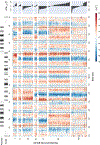Surprising Twists in Nucleosomal DNA with Implication for Higher-order Folding
- PMID: 34192585
- PMCID: PMC8380738
- DOI: 10.1016/j.jmb.2021.167121
Surprising Twists in Nucleosomal DNA with Implication for Higher-order Folding
Abstract
While nucleosomes are dynamic entities that must undergo structural deformations to perform their functions, the general view from available high-resolution structures is a largely static one. Even though numerous examples of twist defects have been documented, the DNA wrapped around the histone core is generally thought to be overtwisted. Analysis of available high-resolution structures from the Protein Data Bank reveals a heterogeneous distribution of twist along the nucleosomal DNA, with clear patterns that are consistent with the literature, and a significant fraction of structures that are undertwisted. The subtle differences in nucleosomal DNA folding, which extend beyond twist, have implications for nucleosome disassembly and modeled higher-order structures. Simulations of oligonucleosome arrays built with undertwisted models behave very differently from those constructed from overtwisted models, in terms of compaction and inter-nucleosome contacts, introducing configurational changes equivalent to those associated with 2-3 base-pair changes in nucleosome spacing. Differences in the nucleosomal DNA pathway, which underlie the way that DNA enters and exits the nucleosome, give rise to different nucleosome-decorated minicircles and affect the topological mix of configurational states.
Keywords: DNA minicircle; Monte Carlo DNA simulation; nucleosomal twist uptake; nucleosome gaping; oligonucleosome array; undertwisted nucleosome.
Copyright © 2021 Elsevier Ltd. All rights reserved.
Conflict of interest statement
Conflict of Interest Statement The authors declare no conflicts of interest.
Figures







Similar articles
-
Changing chromatin fiber conformation by nucleosome repositioning.Biophys J. 2014 Nov 4;107(9):2141-50. doi: 10.1016/j.bpj.2014.09.026. Biophys J. 2014. PMID: 25418099 Free PMC article.
-
Breaths, Twists, and Turns of Atomistic Nucleosomes.J Mol Biol. 2021 Mar 19;433(6):166744. doi: 10.1016/j.jmb.2020.166744. Epub 2020 Dec 10. J Mol Biol. 2021. PMID: 33309853 Review.
-
A distinct switch in interactions of the histone H4 tail domain upon salt-dependent folding of nucleosome arrays.J Biol Chem. 2014 Sep 26;289(39):27342-27351. doi: 10.1074/jbc.M114.595140. Epub 2014 Aug 13. J Biol Chem. 2014. PMID: 25122771 Free PMC article.
-
Beyond the Nucleosome: Nucleosome-Protein Interactions and Higher Order Chromatin Structure.J Mol Biol. 2021 Mar 19;433(6):166827. doi: 10.1016/j.jmb.2021.166827. Epub 2021 Jan 16. J Mol Biol. 2021. PMID: 33460684 Review.
-
Structure-based analysis of DNA sequence patterns guiding nucleosome positioning in vitro.J Biomol Struct Dyn. 2010 Jun;27(6):821-41. doi: 10.1080/073911010010524947. J Biomol Struct Dyn. 2010. PMID: 20232936 Free PMC article.
Cited by
-
Structural interplay between DNA-shape protein recognition and supercoiling: The case of IHF.Comput Struct Biotechnol J. 2022 Sep 19;20:5264-5274. doi: 10.1016/j.csbj.2022.09.020. eCollection 2022. Comput Struct Biotechnol J. 2022. PMID: 36212531 Free PMC article.
-
The Free Energy of Nucleosomal DNA Based on the Landau Model and Topology.Biomolecules. 2023 Nov 23;13(12):1686. doi: 10.3390/biom13121686. Biomolecules. 2023. PMID: 38136559 Free PMC article.
-
The effects of RNA.DNA-DNA triple helices on nucleosome structures and dynamics.Biophys J. 2023 Apr 4;122(7):1229-1239. doi: 10.1016/j.bpj.2023.02.013. Epub 2023 Feb 16. Biophys J. 2023. PMID: 36798026 Free PMC article.
-
emDNA - A Tool for Modeling Protein-decorated DNA Loops and Minicircles at the Base-pair Step Level.J Mol Biol. 2022 Jun 15;434(11):167558. doi: 10.1016/j.jmb.2022.167558. Epub 2022 Mar 24. J Mol Biol. 2022. PMID: 35341743 Free PMC article.
-
Twisting DNA by salt.Nucleic Acids Res. 2022 Jun 10;50(10):5726-5738. doi: 10.1093/nar/gkac445. Nucleic Acids Res. 2022. PMID: 35640616 Free PMC article.
References
-
- Polach KJ & Widom J (1995). Mechanism of protein access to specific DNA sequences in chromatin: a dynamic equilibrium model for gene regulation. J. Mol. Biol 254, 130–149. - PubMed
-
- Mohapatra S, Lin C-T, Feng XA, Basu A & Ha T (2020). Single-molecule analysis and engineering of DNA motors. Chem. Rev 120, 36–78. - PubMed
Publication types
MeSH terms
Substances
Grants and funding
LinkOut - more resources
Full Text Sources

